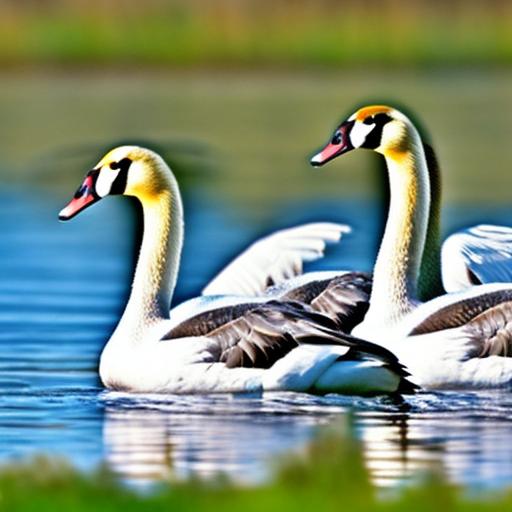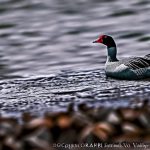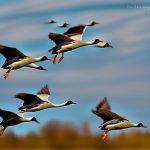Swans and Canada geese are two species of waterfowl that often coexist in the same habitats. While they may seem similar in appearance, their behaviors and interactions can be quite different. Understanding the behavior of both species is crucial for effective management, especially when it comes to controlling Canada goose populations. In this article, we will explore the territorial behavior of Canada geese, how swans interact with them, the role of swans in deterring Canada geese, the effectiveness of using swans for this purpose, other methods for controlling Canada goose populations, the benefits and drawbacks of having swans in areas with Canada geese, and the importance of understanding the behavior of both species for effective management.
Key Takeaways
- Swans and Canada geese often share the same habitats.
- Canada geese are territorial and can become aggressive towards other waterfowl.
- Swans may interact with Canada geese by competing for resources or forming mixed flocks.
- Swans can be effective in deterring Canada geese from certain areas.
- Other methods for controlling Canada geese populations include habitat modification and egg addling.
The territorial behavior of Canada geese
Canada geese are known for their territorial behavior, especially during the breeding season. They defend their territory aggressively against other waterfowl, including other Canada geese and even larger birds such as swans. They use a variety of displays and vocalizations to communicate their dominance and deter intruders. These displays can include hissing, honking, flapping their wings, and charging at intruders.
Examples of aggressive behavior towards other waterfowl can be seen when a Canada goose encounters a swan in its territory. The Canada goose will often approach the swan with its head lowered and wings spread wide, displaying a threatening posture. It may also vocalize loudly to assert its dominance. In some cases, physical confrontations can occur, with the Canada goose attempting to bite or peck at the swan.
How swans interact with Canada geese
Swans have a different approach to territorial behavior compared to Canada geese. While they may also defend their territory, they are generally less aggressive towards other waterfowl. Swans are known for their grace and beauty, and they often prefer to avoid confrontations if possible. When a swan encounters a Canada goose in its territory, it may engage in displays of dominance, such as raising its wings or arching its neck, but it is less likely to engage in physical aggression.
In comparison to Canada geese, swans are more tolerant of other waterfowl sharing their territory. They are less likely to chase away or attack other species, including Canada geese. This difference in behavior can be attributed to the fact that swans are larger and more powerful than Canada geese, and they do not feel as threatened by their presence.
The role of swans in deterring Canada geese
Swans can play a significant role in deterring Canada geese from an area. The presence of swans can act as a natural deterrent for Canada geese, as they are less likely to enter an area that is already occupied by swans. Swans are larger and more powerful than Canada geese, and their presence can signal to the geese that the area is already claimed.
In addition to their size and power, swans also have a territorial behavior that can deter Canada geese. Swans will often display dominance towards other waterfowl, including Canada geese, through displays such as raising their wings or arching their necks. This behavior can intimidate the geese and discourage them from entering the area.
There have been numerous successful examples of using swans to deter Canada geese from an area. For example, in some parks and golf courses, swans have been introduced to control Canada goose populations. The presence of the swans has significantly reduced the number of geese in these areas, leading to less damage to the landscape and fewer conflicts with humans.
The effectiveness of swans in keeping Canada geese away
Several studies have been conducted to assess the effectiveness of using swans to deter Canada geese. These studies have shown mixed results, with some indicating that swans are effective in keeping geese away, while others have found no significant impact.
One factor that can affect the success of using swans is the size of the area. Swans are more likely to be effective in smaller areas, such as ponds or small lakes, where their presence is more noticeable to the geese. In larger areas, such as large lakes or rivers, the impact of swans may be less significant.
Another factor is the behavior of the Canada geese themselves. Some populations of Canada geese have become habituated to human presence and may be less deterred by the presence of swans. In these cases, additional management methods may be necessary to control the geese population.
Other methods for controlling Canada geese populations

While swans can be effective in deterring Canada geese, they are not the only method available for controlling goose populations. There are several other methods that can be used, depending on the specific situation and goals.
Habitat modification is one method that can be used to discourage Canada geese from settling in an area. This can include removing or modifying vegetation that provides food or nesting sites for the geese. By making the area less attractive to geese, their population can be reduced.
Egg addling is another method that can be used to control Canada goose populations. This involves removing and treating eggs to prevent them from hatching. By reducing the number of goslings that are born each year, the population can be controlled over time.
Each method has its pros and cons. Habitat modification can be effective in reducing goose populations, but it may also impact other species that rely on the same habitat. Egg addling can be a humane method of population control, but it requires careful monitoring and coordination to be effective.
The benefits of having swans in areas with Canada geese
Having swans in areas with Canada geese can have several benefits. From an aesthetic perspective, swans are often considered to be more visually appealing than Canada geese. Their graceful movements and elegant appearance can enhance the beauty of a landscape.
From an ecological perspective, swans can also have positive impacts. They are herbivores and feed on aquatic vegetation, which can help control the growth of certain plant species. This can be beneficial in areas where excessive vegetation growth is a problem.
There are also examples of successful coexistence between swans and Canada geese. In some areas, the two species have been observed sharing the same habitat without significant conflicts. This suggests that it is possible for the two species to coexist peacefully if the conditions are right.
The potential drawbacks of using swans to deter Canada geese
While using swans to deter Canada geese can be effective, there are potential drawbacks that need to be considered. One potential negative consequence is increased aggression between the two species. If swans are introduced into an area with existing Canada goose populations, there is a risk that conflicts may arise between the two species.
Another potential drawback is the impact on other wildlife species. Swans are large birds that require ample space and resources. Introducing swans into an area may result in competition for resources with other waterfowl species, potentially leading to negative impacts on their populations.
It is important to carefully consider these potential drawbacks before implementing any management plan involving swans and Canada geese. It may be necessary to consult with experts and conduct thorough assessments of the specific situation before making any decisions.
The importance of understanding the behavior of both species
Understanding the behavior of both swans and Canada geese is crucial for effective management. By understanding their territorial behavior and interactions, managers can develop strategies that minimize conflicts and maximize the effectiveness of control methods.
Consulting with experts who have experience in managing waterfowl populations can provide valuable insights and guidance. These experts can help assess the specific situation, identify the most appropriate management methods, and develop a comprehensive plan that takes into account the behavior of both species.
Conclusion and recommendations for managing Canada geese populations
In conclusion, understanding the behavior of both swans and Canada geese is essential for effective management. Swans can play a significant role in deterring Canada geese from an area, but their effectiveness may vary depending on factors such as the size of the area and the behavior of the geese population.
Using multiple methods, such as habitat modification and egg addling, in combination with swans can increase the likelihood of success in controlling Canada goose populations. It is important to carefully consider the potential benefits and drawbacks of using swans, as well as consult with experts before implementing any management plan.
By taking a comprehensive and informed approach to managing Canada goose populations, it is possible to minimize conflicts and maintain a healthy balance between these two species.
If you’re interested in learning more about how to keep Canada geese away, you might also find this article on Poultry Wizard helpful. It discusses the role of swans in deterring Canada geese and provides insights into their behavior. Check it out here: https://poultrywizard.com/keeping-chickens/hannah-montana-chicken-coop/. For more information on poultry care and breeding, visit Poultry Wizard’s homepage at https://poultrywizard.com. Additionally, if you’re curious about duck mating season and breeding ducks, this article on Poultry Wizard provides valuable information: https://poultrywizard.com/breeding-ducks/when-is-duck-mating-season/.
Meet Walter, the feathered-friend fanatic of Florida! Nestled in the sunshine state, Walter struts through life with his feathered companions, clucking his way to happiness. With a coop that’s fancier than a five-star hotel, he’s the Don Juan of the chicken world. When he’s not teaching his hens to do the cha-cha, you’ll find him in a heated debate with his prized rooster, Sir Clucks-a-Lot. Walter’s poultry passion is no yolk; he’s the sunny-side-up guy you never knew you needed in your flock of friends!







